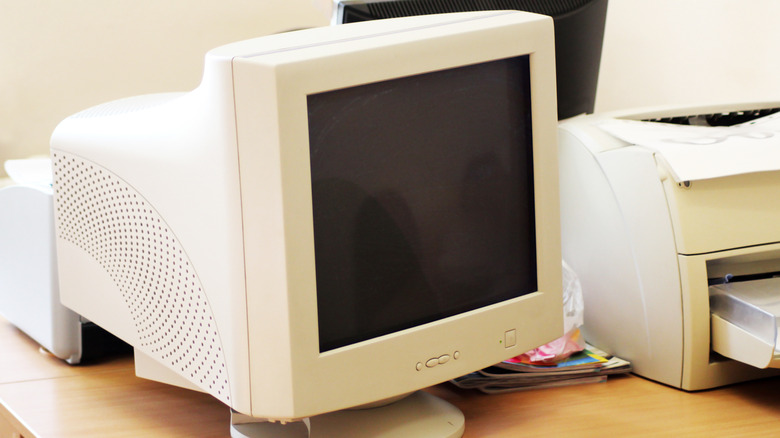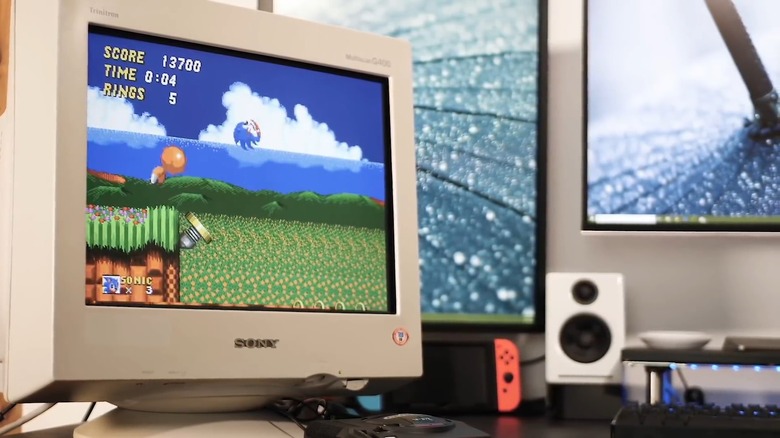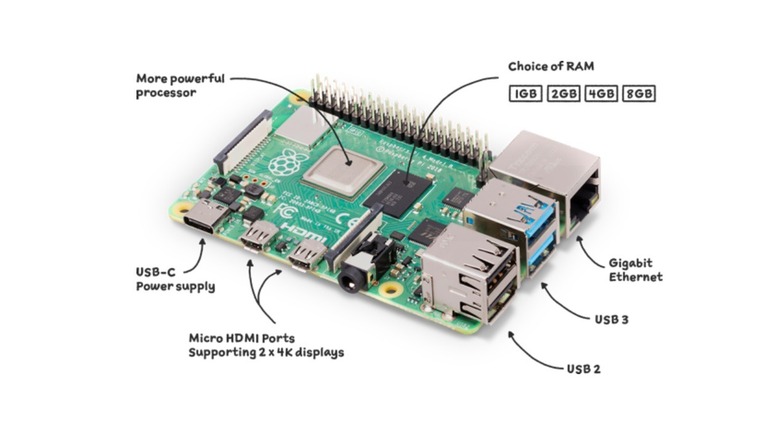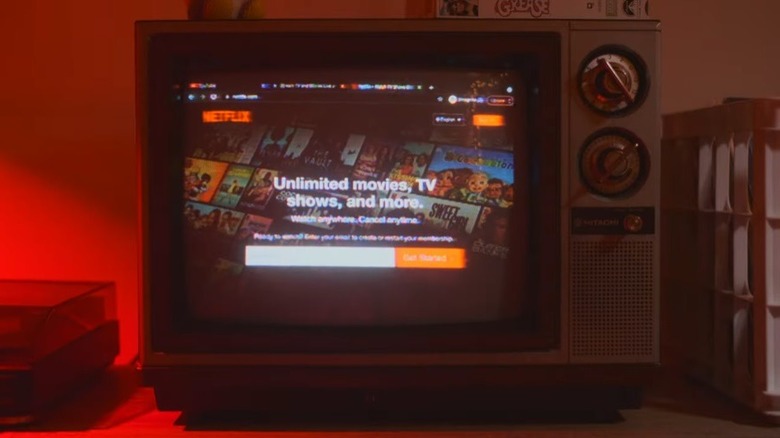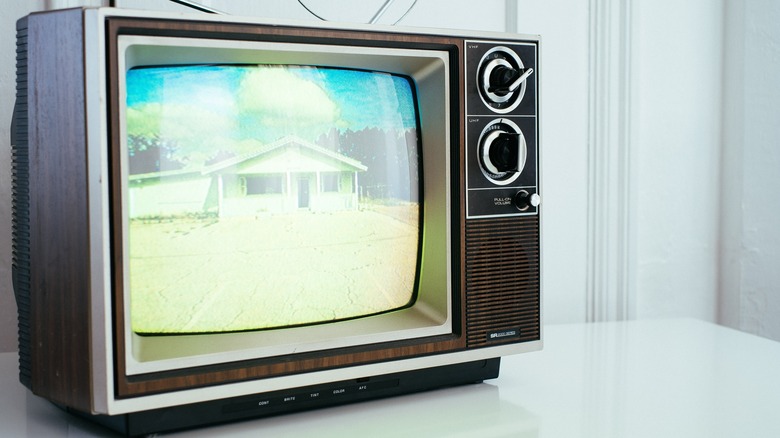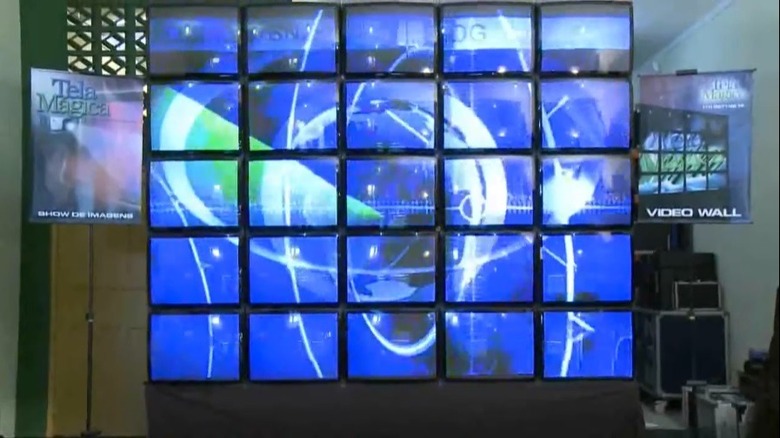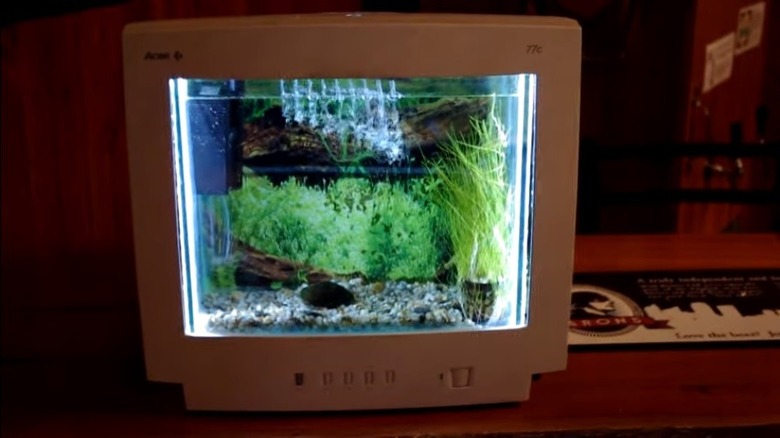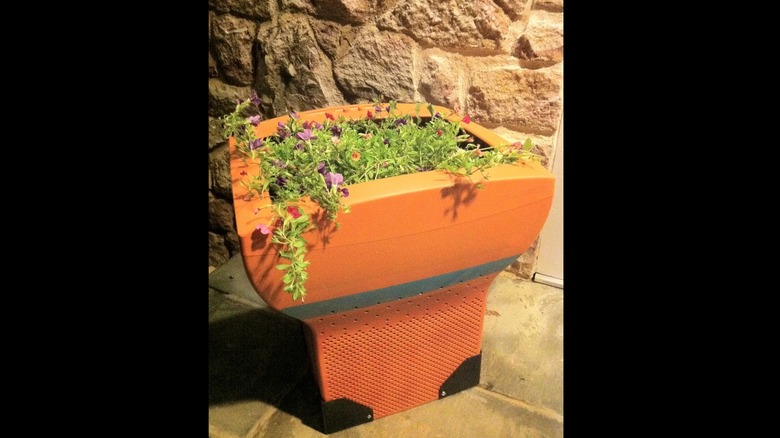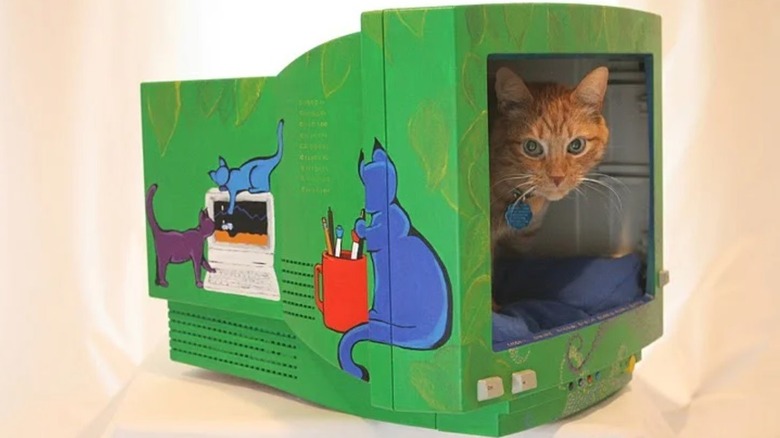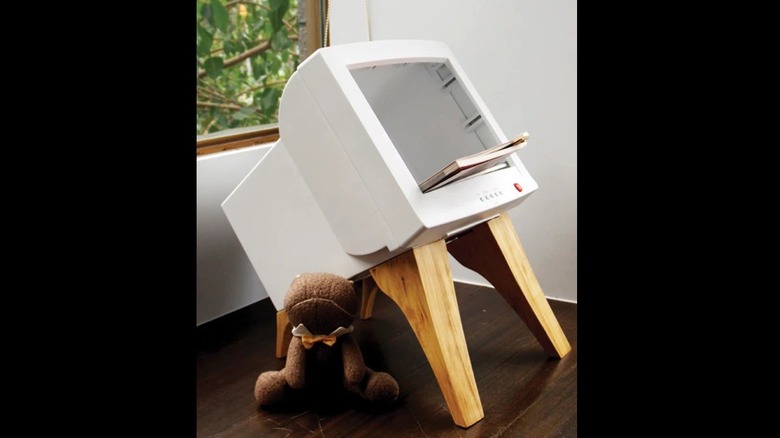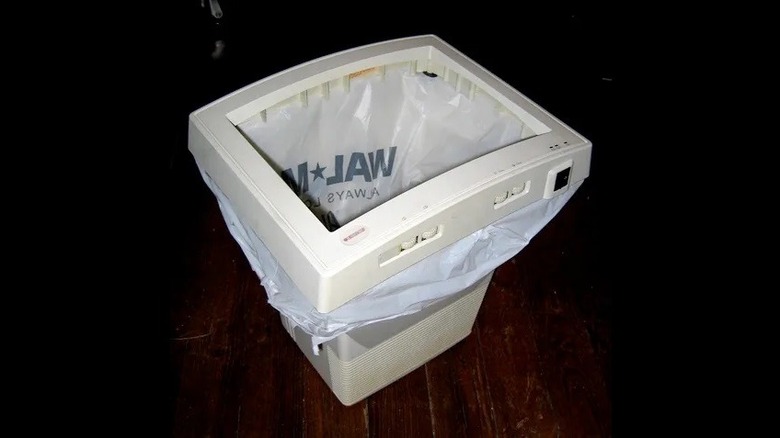10 Best Uses For Old CRT Monitors
Cast yourself back in time for a moment. It's the '80s or '90s and you've just settled down with a big bowl of sugary cereal for the Saturday morning cartoon lineup. A few days later you come home from school, throw down your bookbag, and settle in to play a couple of hours of video games on your Nintendo Entertainment System. The internet exists but it hasn't made its way to your neighborhood yet, you won't learn about AOL Instant Messenger or Hamster Dance for years yet.
There is only one screen in your home — a heavy, bulky, sometimes staticky CRT TV — and all of your entertainment filters through it. It's your slightly bulbous window to the world. CRT (short for cathode-ray-tube) monitors used to be the gold standard in TV and computer monitor hardware. If you wanted to display moving images on a screen, CRT was the way to get it done. When you finally do get home internet, you'll experience it through a CRT monitor, as well.
As display technologies advanced, CRT fell out of use, and thinner, lighter, higher-quality monitors replaced them. Most of them were thrown in the trash or donated to thrift stores. It's too bad, really. Bearing in mind the potential risks involved in fiddling with an old CRT, (via NEDT), there's plenty to do with your old CRT if you happen to have one lying around.
Use it for retro gaming
Whether you're playing video games on a PC or a television and a console, there's little question that game graphics have improved over the last few decades. By almost every measure, any game you pick up today—even ones like Super Meat boy or Stardew Valley which intentionally cop a retro feel—is likely to look better than the ones you played as a kid.
Counterintuitively, that relationship doesn't always hold when you're actually playing retro games from your youth. As explained by How To Geek, older games were designed to work on the displays which were available at the time of their release. An unpredicted consequence is that trying to display them on a modern TV or computer monitor often results in poorer picture quality than you would have experienced decades ago. That's why retro game enthusiasts are snatching up CRTs in order to relive the glory days and play those old games the way they were originally intended, (via Wired).
If you've got an old monitor available, you're ahead of the curve and well on your way to a faithful retro gaming experience. Bear in mind, of course, that the video inputs on a monitor are likely different than they were on a television. CRT monitors mostly used VGA, meaning you'll probably need an adapter to connect your Nintendo 64, (via PCWorld).
Revive it with a Raspberry Pi
Your CRT monitor was only one component of a larger computer system. Unless you had an all-in-one iMac, you probably remember a computer tower on the desk or floor nearby which did the heavy lifting, sending images to the monitor.
If you only have the monitor remaining, or the computer tower is dead, you've essentially got a digital eye with no mind behind it. You could scour the internet, thrift stores, and yard sales looking for a compatible tower or you could create a pocket-sized version using a Raspberry Pi.
Depending on the sort of CRT you have, either a television or computer monitor, the steps for translating the Raspberry Pi's HDMI signal to a compatible output will differ. An adapter, either to VGA or composite display will be required. As explained by Nerd Hut, you might also have to fiddle with the configurations to get the optimum display. The Raspberry Pi forums are a good resource for finding solutions for your specific monitor setup.
Once you've got the video and audio output sorted, however, the possibilities are vast and limited only by the functionality of the Raspberry Pi itself, as well as your patience and technical know-how.
Turn it into a retro smart TV
There's little difference between a CRT computer monitor and a CRT TV, outside of the video inputs. Those are easily remedied, which means turning your old monitor into a working—if antiquated—television is pretty simple.
With a little patience and a few dozen dollars, you can turn your CRT monitor into a working analog television capable of picking up channels over the air. Of course, while your monitor is perfectly capable of displaying analog TV signals, it doesn't have any hardware for picking up those signals. That will be your first hurdle.
As explained by Techwalla, an analog TV tuner box compatible with your monitor's VGA input is likely your best solution. Though, take a moment to look at your monitor and review its connections before you start ordering adapters. The tuner will convert signals into something your old CRT can display. Now you're ready to watch all the infomercials you can stomach.
If you want to bring your old CRT a little closer to the modern-day, you can even turn it into an antique-looking smart TV. Using a smart TV hub like the Chromecast, Fire Stick, or Roku, can get streaming signals to your old monitor. You may need to daisy chain some adapters to get from HDMI to VGA, but that's all that stands in the way of watching Netflix, Hulu, and YouTube as if they'd come out in the '90s, (via Hackaday).
The coolest retro digital photo frame
Digital photo frames were all the rage for a few years, but the novelty has worn off and most people either don't use them or have forgotten about them entirely as they quietly rotate old photos in a forgotten corner of the house. That might be, at least in part, because their contemporary aesthetic is easily overlooked. You can change that by taking their functionality and putting it inside a shell which will draw attention: your old CRT monitor.
Using a Raspberry Pi, either with built-in Wi-Fi or an attached dongle, you can automatically grab photos from a Flickr account or other online source and deliver them to the Pi's SD card, (via Hackaday). Contemporary Raspberry Pis come with HDMI for their video output so, once again, you'll have to get creative in converting that to something your monitor can accept.
The good news is HDMI to VGA converters are relatively affordable and can be acquired online or at your favorite real-world hardware store. You'll have a working digital photo frame that marries modern and old technologies when you're done. Somehow, this makes a better conversation piece than a digital photo frame you could buy off the shelf.
Build a video wall
This one is going to require that you have several CRT monitors. Honestly, the more the better. So, round up all of the old displays your family and friends have been hoarding, or else hit the thrift store until you have at least four you can stack up in a square grid.
Fair warning, this option isn't for the faint of heart, but the result is pretty impressive and conjures feelings of a dystopian sci-fi future as imagined in the 1980s. To get started, you're going to need a dedicated Raspberry Pi for each of your monitors, along with SD cards and video adapters to translate the signal from each Raspberry Pi to each monitor, (via Kyle Zetts).
Now, you're going to have to start coding. Luckily, you can find the code you're going to need either at the above tutorial or on GitHub. By the time you're finished, you'll have a working video wall with each monitor taking a portion of the video to construct a larger image. The result is something that looks futuristic and lost to time, all at once.
Fish tank
At this point, we're putting away our soldering iron and taking out our crafting scissors and paint. The technological uses for an old CRT monitor are limited, owing to its modest native hardware, but the craft options are infinite.
Before we go any further, it's important to note that the insides of a CRT monitor are potentially dangerous. The cathode-ray tube inside is under vacuum and there is a possibility of explosion if you're not careful. CRTs also have heavy metals, and the capacitor can hold a charge for a long time, so there's a risk of electrocution even when it's unplugged. Do your due diligence, wear safety gear, and be careful when dismantling. This applies to every entry on this list, but especially going forward.
Removing the access screws from the exterior will grant you entry to the inside of the CRT and you'll want to remove everything before adding your fish tank. You're going to need plexiglass for the sides and bottom of your tank, as well as silicone or aquarium sealant so that it holds water. It would make a poor tank if it didn't. Cut your glass to fit the monitor interior, seal it, give it a test fill, and mount it inside with expanding foam to hold it in place, (via Instructables). Now, you just need to add a filter, light, bubbler, decorations, and fish and you've got the perfect desktop fish tank to keep you company while you work.
Return to soil
Eventually, we all return to the dirt, why should it be any different for your old CRT monitor? We only want the external casing for this garden planter project, so follow the same steps as you would for the fish tank to open up the case and remove the internal hardware. Bearing in mind that CRT monitors house potentially dangerous materials, be sure to recycle them appropriately, checking your local rulings for guidance.
Once the insides are removed, you can put the case back together. We will use the display hole for the planter opening, so tip your monitor on its back with the display opening facing upward. As explained by Instructables, it's a good idea to add some feet to the back of the monitor to prevent it from tipping.
Place a garden bag or heavy-duty garbage bag inside to hold your soil and plants. If you're using a plastic bag, place a couple of holes in the bottom so water can drain. Now your monitor-turned-planter is ready for plants. Flowers or vegetables growing out of your monitor will give you a 3D viewing experience as you've never seen before.
Make a cat bed
Working from home has a lot of advantages. The commute is short, and your home office has all of the snacks you like. You might even have a cat as an office mate. If you do, you know how much they like to be in your space when you're at the computer. Eventually, you're going to have to face the fact that when you're at your desk, they will be too.
There are a number of reasons for that, and they mostly come down to the fact that your cat loves you and wants the attention you're giving to your computer, (via Reader's Digest).
One strategy for keeping your cat happy while keeping it away from your keyboard is to give them their own decoy computer nearby. That's a perfect solution for an old CRT monitor. Once the insides have been removed and recycled, you're left with a plastic shell and an opening that nicely mimics a small cat carrier or kennel.
Use fabric or pet pillows to guard your cat against any sharp edges which might be inside the monitor casing. You can also paint the exterior and recycle some of your old's computer's other bits to give it a unique aesthetic, (via Instructables).
Now, while you're getting work done, your cat can do the important work of being a cat while leaving you in relative peace.
Make a bookcase or magazine rack
Making a fish tank, planter, or cat bed required some level of vision to see not what a CRT monitor is, but what it could be. For a bookcase or magazine rack, we're stripping the monitor casing down nearly to its bare essentials.
The casing, after all, is simply a shell for holding the electronics which turn code and electrons into moving images. Now that you don't need those electronics anymore, you can use the casing to hold anything you want. At least, anything that will fit. Books and magazines are pretty good candidates.
The options here are limited only by your imagination and design skills. That might mean something as simple as emptying the guts and sticking it on a shelf or desk before filling it with books. If you want to get more creative, you can give your old monitor some legs, making it a full-fledged piece of furniture, transforming it from a piece of garbage cluttering your attic into modern décor.
If you need inspiration, this award-winning concept (pictured above) envisioned by industrial designer Low Yi Siu and posted by Yanko Design should get you started.
Make a trash can
Before you considered alternative uses for your old CRT monitor, it was likely headed for the landfill. Instead of throwing it into the trash, flip the script on that old narrative by throwing your trash into the monitor instead.
Once your old monitor has been emptied of its interior gadgetry, it becomes a perfect receptacle for your junk. While it isn't quite large enough for holding the usual amount of trash generated by a household, it works well with a 13-gallon bag in a bathroom, in the garage, or next to a work desk. Discarding the mounting screws means the front face of the monitor can snap to the backing, holding your bag in place until you're ready to empty it.
This suggestion likely started as a joke when it was posted on Makezine, but honestly, we kind of like it. It says something poignant about the disposable nature of modern technology and the planned obsolescence which is quickly filling our planet with an ever-growing mountain of discarded circuits, silicon, and plastic. At least, that's what you can tell people when they give you the side-eye about having an old monitor as a trash can.
